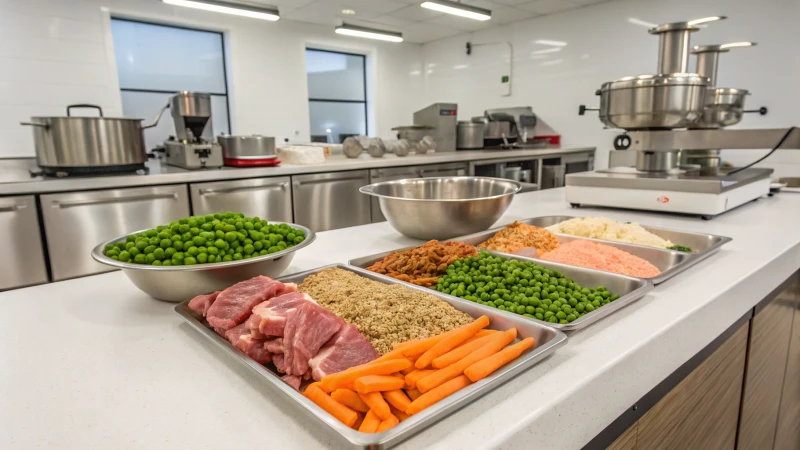
Ever dreamt of crafting your own line of dog food that pets and their owners would love? You're not alone!
To become a dog food maker, start by researching the pet food industry, understanding regulatory requirements, developing a unique product line, and establishing a production process. Ensure your products meet safety standards and market them effectively to pet owners.
Getting into the dog food industry was something I pondered for a while before diving in headfirst. There’s so much more than just mixing ingredients. It’s about understanding the market trends and learning how to innovate while keeping nutritional value at the forefront. Imagine the joy of seeing a dog wag its tail enthusiastically at mealtime because of something you created! In our detailed guide, I share insights and tips that helped me navigate this complex yet rewarding journey. Whether you're starting out or looking to refine your process, these insights can be the game-changer you need.
Dog food makers must meet regulatory standards.Правда
Regulatory standards ensure the safety and quality of dog food products.
All dog food businesses require a physical store.Ложный
Many dog food businesses operate online without a physical storefront.
Каковы юридические требования для открытия бизнеса по производству корма для собак?
Starting a dog food business is like diving into a world where passion for pets meets the practicalities of regulations and safety. It's a journey worth taking, but what legal steps do you need to consider along the way?
To start a dog food business, you'll need to comply with FDA guidelines, secure necessary permits, and ensure your products meet nutritional standards. Understanding labeling and safety regulations is crucial for legal operation.
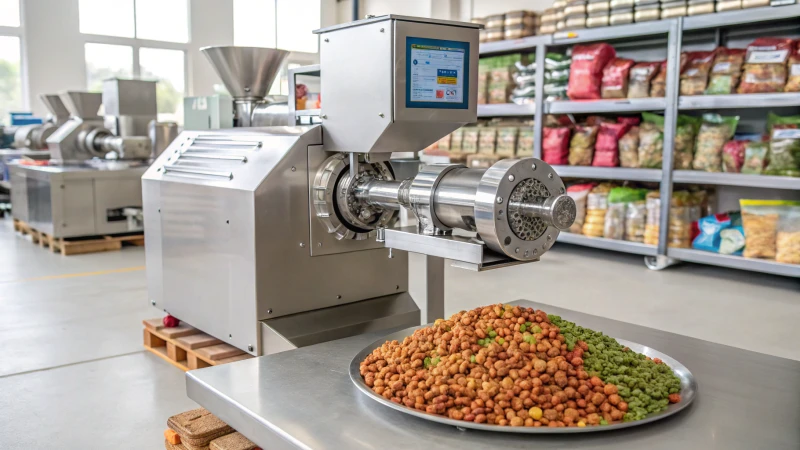
Понимание FDA Руководство
When I first considered starting a dog food business, the FDA guidelines felt like deciphering a complex puzzle. Ensuring my products were safe and nutritious required digging into the details of regulations. The FDA's comprehensive framework1 covers everything from ingredients to packaging, which is essential for ensuring that my dog food isn't just tasty but also safe for our furry friends.
Key Areas of Compliance
- Ингредиенты одобрены: I had to meticulously check that every ingredient was approved and safe for dogs to consume. This step made me feel like a culinary detective, ensuring each element was just right.
- Facility Registration: Registering my facility with the FDA wasn't just a bureaucratic step; it felt like getting an official badge of responsibility.
- Nutritional Standards: Meeting the AAFCO standards meant my products wouldn't just fill bowls but would nourish dogs properly.
Securing Necessary Permits
The thought of navigating local permits initially seemed daunting. Different states have their own requirements, and understanding these was crucial. Speaking with local authorities was not only informative but also reassuring, helping me feel connected to my community and its standards.
| Permit Type | Описание |
|---|---|
| Разрешение на производство | Required for facilities producing dog food. |
| Sales Permit | Needed to sell products directly to consumers or retailers. |
Labeling and Packaging Requirements
Creating labels that were both compliant and appealing was like blending science with art. Accurate labeling is key to building trust with customers. I ensured our labels included everything from product names to guaranteed analyses, satisfying both legal requirements and consumer curiosity.
Important Label Components:
- Product Name: Clearly stating the type of dog food was my first step towards transparency.
- Ingredients List: Listing ingredients by weight made me feel like a responsible guardian of pet health.
- Гарантированный анализ: Providing nutritional information was more than compliance; it was about educating pet owners.
Безопасность и контроль качества
Implementing safety measures felt like setting up a protective barrier around my passion project. Regular testing and quality checks became my routine to prevent contamination and ensure consistency.
- Hazard Analysis Critical Control Points (HACCP): Использование HACCP made me feel proactive, identifying and preventing potential hazards before they could affect my products.
- Программы обеспечения качества: Regular audits gave me peace of mind, knowing that every batch met our high standards.
Navigating International Standards
When thinking about exporting, understanding international regulations became crucial. Each country has unique standards, and navigating these waters required expert advice. Consulting with professionals in global pet food regulations2 helped me align my business strategy with global demands.
By adhering to these legal requirements, not only could I build a reputable and compliant business, but I also fostered trust among pet owners who rely on us for their pets' nutrition. This journey has been as rewarding as it has been challenging, cementing my commitment to quality and safety.
FDA regulates dog food ingredient approval.Правда
FDA гарантирует, что все ингредиенты в корме для собак безопасны и одобрены.
Sales permits are unnecessary for selling dog food.Ложный
Sales permits are required to sell dog food directly to consumers or retailers.
How can I create a distinctive dog food product line?
Starting a unique dog food line isn't just about ingredients; it's about creating a blend of passion, innovation, and understanding what our furry friends truly need.
To develop a unique dog food product line, focus on understanding market trends, identifying a niche audience, and ensuring nutritional adequacy. Utilize certifications and innovative ingredients to differentiate your offerings.

Understanding the Market and Audience
Let me take you back to when I first embarked on this journey of crafting a dog food line. Like many pet lovers, I wanted to ensure every product was something I'd feel proud to feed my own dogs. So, I dug deep into тенденции рынка3 and listened closely to what fellow pet owners were saying. From online communities to in-person meetups, these insights became the backbone of my strategy.
I also remember conducting surveys—simple questions that led to profound insights about what was missing in the market. Knowing what pet parents are looking for helped me tailor products that not only filled these gaps but also delighted our furry companions.
Defining Your Unique Selling Proposition (USP)
Defining a USP wasn't just a business strategy; it was personal. I wanted something that resonated with me and my values. So, I asked myself what would make my dog food stand out? Was it the organic ingredients? Or perhaps catering to specific dietary needs like grain-free or hypoallergenic options? In the end, I realized it was about creating something I would trust with my dogs' health.
Ensuring Nutritional Adequacy
Partnering with animal nutritionists was key. They helped me ensure that the nutritional profile of my products met all necessary standards, guided by organizations like the AAFCO. This partnership reassured me that I was offering safe and effective products.
| Питательные вещества | Recommended Level |
|---|---|
| Протеин | 22% for puppies |
| Жир | 8% for adults |
| Кальций | 1% for large breeds |
This table was more than numbers; it provided peace of mind that my dog food could support different life stages and breeds.
Leveraging Certifications and Quality Standards
Certifications weren't just a checklist item for me; they were about building trust. Having USDA Organic or non-GMO certifications meant I could confidently say to my customers, "Yes, this is good enough for your pet." Additionally, achieving ISO 9001 certification reflected my commitment to quality management standards.
Innovating with Ingredients and Formulations
Innovation was where creativity met science. By experimenting with ingredients like superfoods such as chia seeds4 or probiotics, I aimed to offer not just food but health benefits in every bite. This part of the process felt like art—where every ingredient played a role in crafting the perfect meal.
Through these strategies, I've been able to create a dog food line that's not only competitive but also deeply connected to the needs and desires of pet owners everywhere.
Organic ingredients in dog food are a unique selling point.Правда
Using organic ingredients sets a product apart by appealing to health-conscious consumers.
ISO 9001 certification is irrelevant for pet food quality.Ложный
ISO 9001 certification demonstrates a commitment to quality management, enhancing product credibility.
What Equipment Is Needed for Dog Food Production?
Setting up a dog food production line? Trust me, getting the right equipment makes all the difference. I've been there, sifting through choices to ensure my process ran smoothly and efficiently.
Dog food production requires specialized equipment such as mixers, extruders, dryers, and packaging machines. Each plays a vital role in transforming raw ingredients into safe, nutritious pet food.
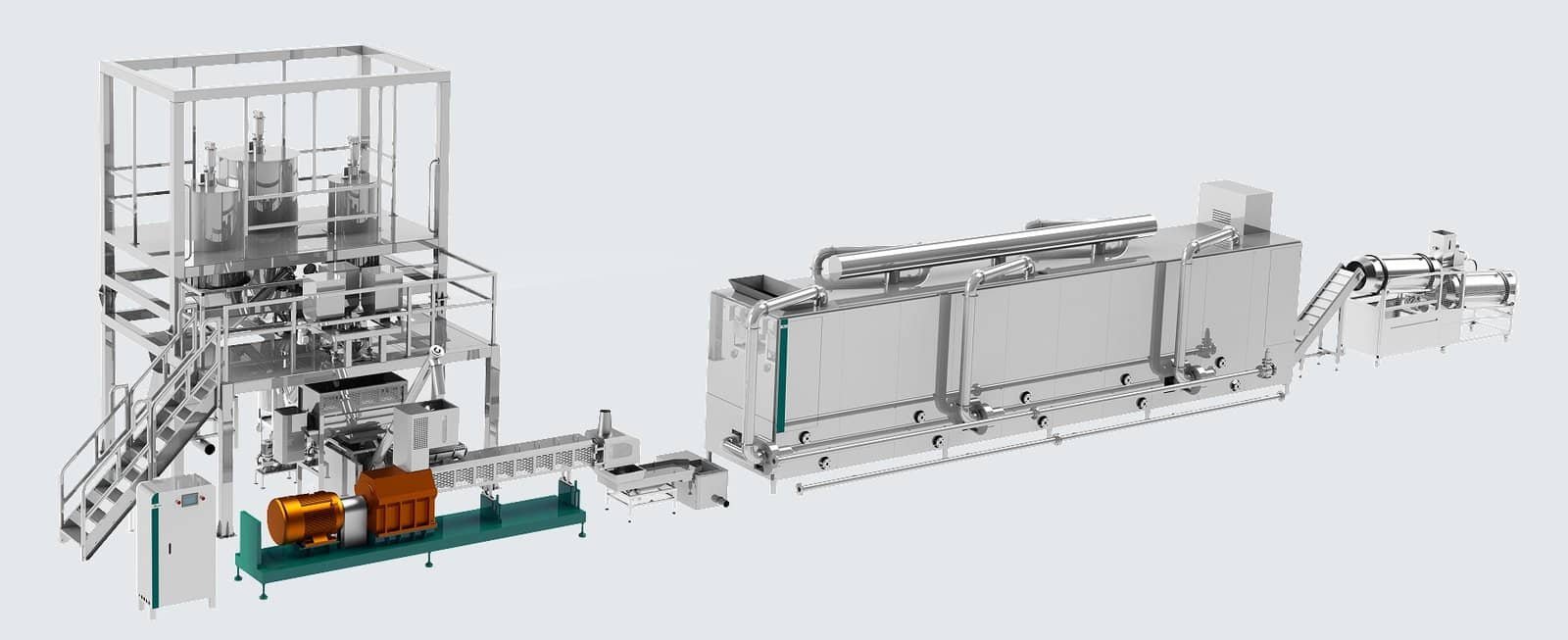
Понимание основ производства кормов для собак
When I first ventured into the world of dog food production, I quickly realized that each stage of the process demanded its own set of specialized machinery. Let me walk you through the essentials:
Миксеры: These are the unsung heroes in the kitchen of dog food production. Mixers are tasked with blending raw ingredients into a uniform mixture, no small feat when you're dealing with textures ranging from dry kibble to more moist concoctions. I remember the learning curve of adjusting settings to get that perfect mix.
Экструдеры: I like to think of extruders as sculptors, transforming ingredients under heat and pressure into pellets. These pellets can then be cut to any size you need, providing that satisfying crunch dogs love.
Сушильные машины: Dryers are crucial for preserving food quality. They remove moisture to prevent spoilage, and choosing the right type—whether it be hot air or infrared technology—can make a significant difference in product longevity.
Машины для нанесения покрытий: Once the drying process is complete, these machines step in to add flavoring or nutritional coatings. It's a bit like adding icing on a cake, enhancing appeal and nutritional value.
Упаковочные машины: Protecting the final product is paramount. Packaging machines vary from fully automated systems to semi-automatic options, all designed to shield your product from contamination and extend its shelf life.
Detailed Look at Each Machinery Type
| Оборудование | Назначение |
|---|---|
| Миксеры | Blend raw materials for uniform texture |
| Экструдеры | Shape and cook food into desired forms |
| Сушильные машины | Remove moisture to preserve freshness |
| Машины для нанесения покрытий | Apply flavoring and nutrients |
| Упаковочные машины | Ensure protection and longevity of the product |
Each piece of equipment plays a pivotal role in the производственный процесс5. Your choice will depend on factors like production scale and the specific types of products you're aiming to create.
Advanced Technologies in Dog Food Equipment
In my journey, I've seen how embracing modern technologies can revolutionize operations:
Автоматизация: This was a game-changer for me. Automation reduces manual labor, boosting efficiency as it handles mixing, extrusion, drying, and packaging with minimal intervention.
Умные датчики: They provide peace of mind by monitoring parameters like temperature and moisture, ensuring consistent quality and safety.
Энергоэффективность: My move to energy-efficient models helped me save on costs while supporting environmental sustainability goals.
Exploring these innovative solutions6 can lead to better product consistency and reduced operational costs.
Considerations When Selecting Equipment
Choosing the right equipment can feel overwhelming, but here's what helped me:
- Capacity Needs: Align machine capacity with your production goals.
- Соответствие нормативным требованиям: Verify that machines meet standards like CE or ISO, crucial for international reach.
- Гибкость: Look for machines that can adapt to different product types or allow for upgrades.
Evaluating these factors helps align equipment choices with business objectives and отраслевые тенденции7.
Extruders are used to add flavor to dog food.Ложный
Extruders shape and cook food, not add flavor. Coating machines do that.
Mixers ensure uniform texture in dog food production.Правда
Mixers blend raw materials to achieve a consistent texture in the product.
How can I market my dog food brand effectively?
Ever tried getting your dog to eat something new? Marketing dog food is kinda like that—tricky but rewarding.
To effectively market your dog food brand, focus on understanding your target audience, leveraging digital marketing, utilizing social proof, and offering unique value propositions. Tailor these strategies to resonate with pet owners' preferences and concerns.
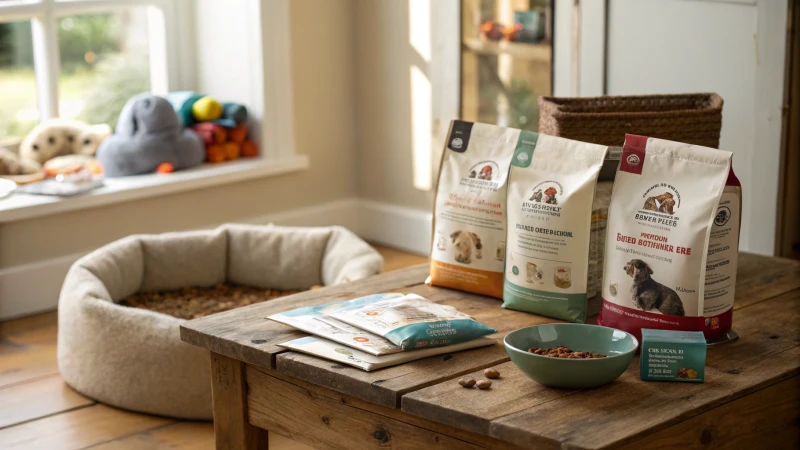
I remember the first time I launched my own line of dog food. It was exhilarating but also daunting. I mean, how do you even start to convince pet owners that your kibble is the one their furry friend should munch on? Here's how I managed to crack the code.
Понимание целевой аудитории
When I first stepped into this industry, I realized that knowing who’s buying the product is crucial. Dog owners have a wide array of needs depending on their pets' age, breed, and health status. I conducted surveys and even organized a few casual focus groups over coffee (and dog treats, of course) to gather insights. Creating a detailed customer persona became my guiding light for all things marketing. By considering factors like age, income level, location, and lifestyle, I was able to tailor content that truly resonated.
Использование цифрового маркетинга
Digital marketing was a game-changer for me. I started by using social media platforms like Instagram and Facebook to showcase my products. High-quality images and engaging videos were key to capturing pet owners' attention. I also dabbled in paid advertising to boost reach. These platforms offer targeted ads, making it possible to reach specific demographics with precision. Incorporating search engine optimization8 was another step that improved my brand's visibility online, making it easier for potential customers to find us.
| Платформа | Назначение | Тип содержимого |
|---|---|---|
| Visual engagement | Фотографии, Истории | |
| Community building | Videos, Posts | |
| Search visibility | SEO-optimized ads |
Utilizing Social Proof
Building trust was another hurdle I faced, but social proof came to the rescue. Encouraging satisfied customers to leave positive reviews on platforms like Google Reviews and Amazon became part of my strategy. Collaborating with influencers in the pet industry who could authentically promote my brand significantly increased credibility and awareness among their followers. Using customer testimonials9 on my website also helped showcase real-life success stories.
Offering Unique Value Propositions
I knew from the start that differentiating my brand was essential. By highlighting unique features like organic ingredients or tailored nutrition plans for dogs with specific dietary needs, I managed to stand out. Developing limited edition products or themed collections aligned with current trends—like eco-friendly packaging—attracted environmentally conscious consumers.
Incorporate a table for comparing dog food brands gave pet owners a clear view of why they should choose my brand:
| Характеристика | Бренд A | Бренд B | Ваш бренд |
|---|---|---|---|
| Органические ингредиенты | Да | Нет | Да |
| Custom Nutrition Plan | Нет | Да | Да |
| Экологически чистая упаковка | Нет | Да | Да |
By addressing these aspects, you can effectively position your dog food brand in the market. Each strategy should be continually assessed and adjusted based on consumer feedback and market trends.
Instagram is ideal for visual engagement in dog food marketing.Правда
Instagram's focus on photos and stories makes it perfect for showcasing products.
All dog owners have the same dietary needs for their pets.Ложный
Different breeds and ages require specific nutrition, varying owner needs.
Каковы расходы, связанные с открытием бизнеса по производству корма для собак?
Diving into the dog food business isn't just about loving pets—it's a whole financial commitment. Understanding what you're signing up for is crucial.
Starting a dog food business involves several costs, including product development, equipment, and marketing. Initial expenses typically range from $50,000 to $200,000, depending on scale. Key costs include licensing, ingredient sourcing, production equipment, and regulatory compliance.

Initial Setup Costs
Когда я впервые задумался о создании бизнес по производству корма для собак10, I quickly realized it's not just about mixing up some tasty meals for our furry friends. It's about having a robust financial plan to get things off the ground. Costs can swing wildly depending on whether you're dreaming of a small kitchen operation or envisioning a bustling production facility.
Licensing and Registration: Believe me, dealing with permits and licenses is one of those things you can't skip. Depending on where you're located, you're looking at spending anywhere from $500 to $2,000 just to get the legal green light.
Разработка продукта: This is where the magic happens—or so I thought until I saw the price tag! Crafting unique recipes that stand out can set you back between $5,000 and $15,000. This includes everything from research to ingredient sourcing.
Equipment and Facility Expenses
Investing in quality equipment isn't just a nice-to-have; it's essential for smooth operations. Here’s a quick look at what you might spend:
| Тип оборудования | Примерный диапазон затрат |
|---|---|
| Mixing Machines | $10,000 - $30,000 |
| Упаковочное оборудование | $8,000 - $20,000 |
| Storage Facilities | $5,000 - $15,000 |
It’s worth weighing whether brand-new machinery is necessary or if second-hand options could serve your needs just as well.
Ingredient and Production Costs
Ingredients are where costs can really fluctuate. If you're like me and want to keep quality high without breaking the bank, consider bulk buying or sourcing locally.
Сухие ингредиенты: These are staples in kibble production but watch the market trends—they can send prices on a rollercoaster ride.
Specialty Ingredients: Organic or exotic ingredients might boost your appeal but brace yourself for the price hike they bring.
Marketing and Distribution Expenses
When I launched my product, I learned marketing is not something you want to skimp on. Allocating funds to branding and distribution can make all the difference in reaching pet owners.
Цифровой маркетинг: An online presence is crucial. An initial investment between $2,000 to $10,000 can set you up for success.
Дизайн упаковки: Your packaging needs to pop! Expect to shell out anywhere from $1,000 to $5,000 for design and materials.
And don’t forget about distribution channels or e-commerce platforms—they might come with extra fees but can significantly boost your market reach.
Regulatory Compliance Costs
Navigating food safety standards is like having a safety net. Testing and certifications can cost between $1,000 and $5,000 annually. Making sure you’re compliant with organizations like the FDA or regional equivalents isn’t just about avoiding fines—it’s about building trust with your customers.
Exploring these cost factors helps in strategic budgeting and ensures you're prepared for any financial surprises in this competitive industry.
Licensing costs for a dog food business exceed $5,000.Ложный
Licensing costs range from $500 to $2,000, as stated in the context.
Mixing machines can cost up to $30,000 for dog food production.Правда
The context specifies that mixing machines range from $10,000 to $30,000.
How can you ensure quality and safety in dog food manufacturing?
Ever wondered how dog food manufacturers ensure the best for our furry friends? Dive into the meticulous processes that keep dog food safe and top-quality.
To ensure quality and safety in dog food manufacturing, implement Good Manufacturing Practices (GMP), adhere to Hazard Analysis Critical Control Points (HACCP) protocols, conduct regular testing, and comply with relevant нормативные стандарты.
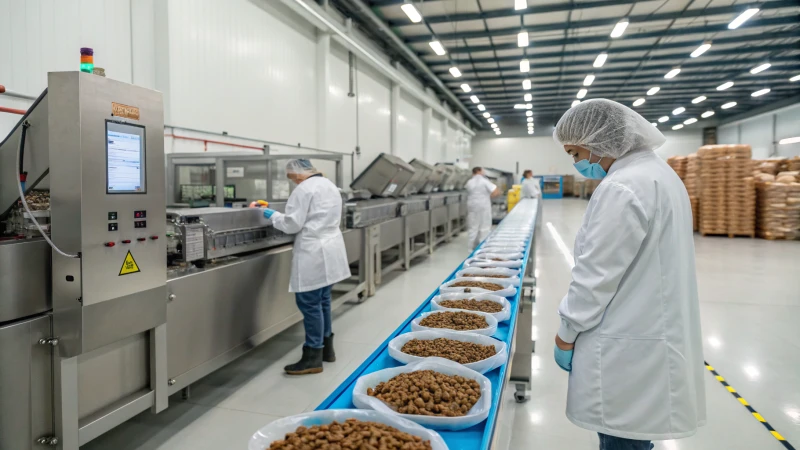
Understanding GMP and HACCP
You know, when I first got into the world of pet food manufacturing, it felt like stepping into a whole new universe. There's so much behind every kibble and treat that most people wouldn't even guess. Good Manufacturing Practices (GMP) are like the backbone of this universe. They're the reason each batch maintains the same high standards—from selecting the right raw materials to ensuring that the packaging is up to snuff. This consistency isn't just about following a checklist; it's about preventing contamination and keeping our furry pals safe.
Hazard Analysis Critical Control Points (HACCP) was a real eye-opener for me. Imagine having a crystal ball that lets you foresee potential hazards before they become real problems. That's what HACCP does—it allows us to identify critical points in the process where things could go wrong and put safeguards in place. It's like having a superhero team working behind the scenes to keep everything running smoothly.
| GMP Elements | HACCP Steps |
|---|---|
| Контроль качества | Hazard analysis |
| Санитария | Identify CCPs |
| Personnel training | Set limits |
| Equipment maintenance | Monitor procedures |
Importance of Regular Testing
Regular testing has been a game-changer for me. It's not just about ticking boxes; it's about peace of mind. When I first introduced regular microbiological and nutritional tests, I realized how crucial they were in ensuring dog food safety11. It's comforting to know that every treat we produce won't have any unwelcome surprises like Salmonella or E.coli. Plus, these tests make sure that what's on the label matches what's inside—so every dog gets the balanced nutrition promised.
Regulatory Compliance and Certification
Navigating regulations can feel daunting, but it's non-negotiable when it comes to dog food safety. Partnering with organizations like the FDA или AAFCO has been invaluable. Certifications such as ISO 22000 or BRC Global Standards aren't just fancy badges; they reflect a deep commitment to quality management systems that enhance consumer trust12. I've learned that collaborating with industry experts or using specialized software can really streamline compliance tracking and documentation processes.
Sourcing High-Quality Ingredients
I can't stress enough how vital it is to source high-quality ingredients from reputable suppliers. It's a bit like finding trustworthy friends; you want those who stand by their word and quality. Performing audits and maintaining open communication channels have helped me ensure they adhere to our standards. Opting for suppliers that offer traceability from source to finished product is key to safeguarding against contaminants13.
I've even considered forming partnerships with local farmers or cooperatives. Not only does this reduce transportation risks, but it also supports sustainable sourcing practices—something I'm incredibly passionate about.
GMP prevents contamination in dog food manufacturing.Правда
GMP involves strict controls to prevent contamination in production.
HACCP is optional for dog food manufacturers.Ложный
HACCP is essential for identifying and controlling potential hazards.
Заключение
Learn how to become a dog food maker by understanding industry regulations, developing unique products, ensuring safety standards, and effectively marketing to pet owners.
Discover detailed FDA regulations to ensure compliance in manufacturing safe and nutritious dog food. ↩
Understand global standards for exporting dog food to expand your business internationally. ↩
Explore current trends in pet nutrition to align your product development with consumer interests. ↩
Discover the health benefits of chia seeds for dogs to enhance your product's appeal with nutritious ingredients. ↩
Discover comprehensive insights into each step of dog food production. ↩
Learn about cutting-edge technologies enhancing pet food production. ↩
Stay updated with the latest trends influencing the pet food sector. ↩
Discover how SEO can enhance online visibility and attract more pet owners. ↩
Learn the importance of customer testimonials in building trust and increasing sales. ↩
Explore additional insights on financial requirements for launching a dog food company. ↩
Explore how nutritional tests verify that dog foods meet label claims for balanced nutrition. ↩
Discover certifications that enhance consumer trust by demonstrating commitment to quality systems. ↩
Learn why traceability from source to product is crucial for preventing contamination. ↩









